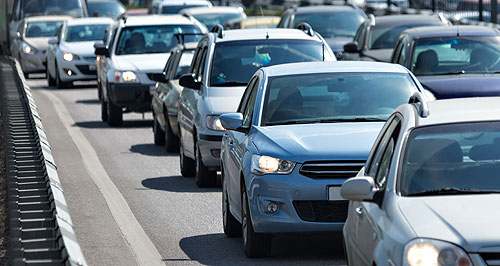Make / Model Search
News - General News - EmissionsCautious welcome for emissions discussion paperNo smoke without ire: The federal government acknowledges that Australia lags the developed world on vehicle emissions, but industry bodies advise caution on how it goes about catching up. Thorough consultation needed for smooth vehicle emissions transition: AAA, FCAI12 Feb 2016 THE Australian Automobile Association (AAA) and Federal Chamber of Automotive Industries (FCAI) have cautiously welcomed this week’s release of the federal government’s Vehicle Emissions Discussion Paper, respectively urging thorough consultation and consideration of Australia’s unique market conditions. Representing Australia’s eight motoring clubs, the AAA reiterated its call for the government to ensure “transport cost and equity to remain central considerations” in its quest for emissions reductions and to work closely with stakeholders to make sure they are “achieved in a fair and cost effective manner”. Weighing in from a new-car importing and manufacturing perspective, the FCAI highlighted the need for a solution that takes into account Australia’s “market, consumers and driving needs”, and the commitment of the industry it represents to help establish a CO2 emissions target “that takes into account the realities of the Australian market and will produce real fuel consumption savings to Australians”. Federal environment minister Greg Hunt described the discussion paper as examining “options for improving standards for air pollutants and fuel efficiency (CO2) standards, ways to better educate and inform consumers, alternative fuels and electric vehicles, the use of incentives and bolstering emissions testing arrangements”. The discussion paper warns that a failure to improve vehicle fuel-efficiency – and therefore emissions – in Australia will increase the cost of living for consumers and harm the competitiveness of local businesses on the world market through higher transport costs. AAA chief executive Michael Bradley said the government must be careful that its attempts to reduce emissions do not end up having the same effect, pointing out the risk of “unintended consequences that may impact fuel prices, reduce the choice of vehicles available to consumers, restrict travel options or slow down the overall renewal and modernising of Australia’s car fleet”. However, both Mr Bradley and FCAI chief executive Tony Weber acknowledged the level of detail included in the discussion paper, which Mr Bradley said made clear that “a great deal of consultation will be required on behalf of the Government to arrive at fair and effective policy settings”. Mr Weber said he was “pleased the Government has recognised in its discussion paper the need to consider all of these factors before a target can be determined”. Following the success of programs in the United States and European Union, the discussion paper makes a strong case for Australia to introduce some kind of CO2 emissions standards and provides a comparison of Australia’s current and projected light passenger and commercial-vehicle CO2 emissions against other markets, which it says “demonstrates that Australia is projected to fall behind the EU and the US”. Referring to the flow-on effect of vehicles imported to Australia from countries that have adopted emissions standards, the paper predicts that emissions “will continue to improve under a business as usual scenario”, but that Australian emissions have not fallen “at the rates in other countries where mandatory standards and other measures are in place”. It concludes that “a key factor in this is that both the US and the EU have introduced fuel efficiency (CO2) standards”. The discussion paper also points out that compared with the US, EU and Japan, Australia’s standards regulating noxious emissions (such as particulates and oxides of nitrogen) “are less stringent than those in comparable countries”, threatening air quality and public health against a backdrop of Australia’s ageing and increasingly urbanised population. Mindful of this, Mr Weber referred to a recent presentation to the government by industry research firm IHS Automotive, which demonstrated that Australia “needs its own solution for emissions reductions”. “When looking at the facts, they state that no ‘cookie cutter’ approach can work. Australia is not Europe or the United States, and has its own unique market, consumers and driving needs.”  Left: FCAI chief executive Tony Weber (top) and AAA chief executive Michael Bradley. In its Greenhouse and Vehicle Emissions Policy Principles, the AAA also agrees that “the adoption of any foreign or international emissions standards must take into consideration the Australian new vehicle fleet and how and why it differs from those found in other markets”. Left: FCAI chief executive Tony Weber (top) and AAA chief executive Michael Bradley. In its Greenhouse and Vehicle Emissions Policy Principles, the AAA also agrees that “the adoption of any foreign or international emissions standards must take into consideration the Australian new vehicle fleet and how and why it differs from those found in other markets”.The discussion paper takes these points this into account, for example citing recent findings by the National Transport Commission (NTC) that “Australian consumers had a much stronger preference than their UK counterparts for larger, more powerful vehicles, and for vehicles with automatic transmissions”. “When considering Australia’s reduction of CO2 in the light vehicle fleet it is worth noting that broadly, consumer preferences within the Australian market are currently more closely aligned with the US market than EU markets,” the paper points out. Another proposal in the discussion paper is that following the local manufacturing exit at the end of 2017, government fleet purchasing policy is based on individual vehicle and fleet average emissions targets. Supporting the purchase of electric and alternative-fuel vehicles by government fleets is also mooted, although cost and infrastructure barriers are cited in the discussion paper. More broadly, changes to Luxury Car Tax breaks could be extended to vehicles meeting certain CO2 or noxious emissions criteria. Changes to the fuel tax credit for heavy vehicle operators are also on the table, including incentives for the adoption of newer, more efficient models. It is also ominously noted that high fuel prices in Europe have helped drive the uptake of efficient vehicles. State and territory registration fees and stamp duty charges could also change based on the Australian Capital Territory model that bases the level of stamp duty on CO2 output, or the Queensland version where electric and hybrid vehicles have the lowest stamp duty rate and those with seven or more cylinders pay top whack. While Australia will only adopt Euro 5 noxious emissions standards for light vehicles from November 1 this year, Euro 6 for light vehicles became mandatory in Europe from September 2014 and the discussion paper says equivalent standards are also currently in force in the US and Japan. Australia is also behind on heavy vehicle emissions, with Euro V (roman numerals are used for standards applying to models with a gross vehicle mass greater than 3.5 tonnes) introduced in Australia on models produced from January 1 2011, even though it is superseded by Euro VI, which was adopted in Europe at the end of 2012, while the discussion paper says equivalent standards came into effect in the US and Japan in 2010. At this point the debate over Australian fuel quality rears its head, with a clash between the World Wide Fuel Charter 2013 that says petrol containing a maximum of 10 parts per million (ppm) of sulphur is needed to meet the durability requirements of the Euro 6 noxious emissions standards, and Australian refineries, which question whether 10 ppm is really necessary and suggest the costs of producing lower sulphur fuel may affect the viability of their local operations. As a result, Australia’s adoption of Euro 6 could be informed by the ongoing review of the Fuel Quality Standards Act. Mr Weber was pleased the discussion paper “recognised the inter-relationship of fuels, pollutant emissions and CO2 emissions”, and highlighted the importance of considering “a range of policy matters, including fuel quality, infrastructure and incentives for the take up of low-emissions vehicles, and driver behaviour”. The discussion paper highlights the Volkswagen Group emissions-testing defeat device scandal and Australia’s engagement with international regulators to explore the options for introducing a global standard for real-world emissions testing, potentially based on the European Union’s recently agreed Real Driving Emissions test. “As a new and more robust test procedure for measuring light vehicle efficiency and emissions is expected to be adopted in EU and UN vehicle regulations in the next few years, the Australian Government will consider the merits of adopting this new test cycle to inform the current fuel consumption labelling standard,” says the paper. It also suggests the potential for developing a real-world adjustment factor for CO2 emissions, as used in the US. The AAA wants to take the testing regime further, calling for “independent testing of vehicle emissions under real world driving conditions (that) must be undertaken using Australian vehicles on Australian roads”. Subsidies for electric vehicles as seen overseas are likely to get short shrift in Australia, with the discussion paper citing a recent report by research firm Energia that found the cost of subsidies “outweighed benefits such as economic and employment growth and air quality improvements”. The emissions intensity of generating electricity in Australia is also cited as a barrier, although the discussion paper concedes that pollution from power stations will fall over time due to initiatives such as the Renewable Energy Target and improvements in the cost competitiveness of renewables. It is a similar case for hydrogen fuel-cell vehicles, due to the energy required to produce large quantities of hydrogen. However potential factors contributing to a case for government support of electric and hydrogen vehicles include “improved fuel security and improved utilisation of electricity generation and network assets”. But the FCAI would like to see more government input to infrastructure and incentives designed to accelerate the uptake of alternative-fuel vehicles in Australia. “To effectively introduce a range of low-emissions vehicles, it is important the industry and governments work together to provide the appropriate infrastructure. In countries such as Japan, government-led consumer incentives and infrastructure investment played significant roles in the uptake of vehicles with these technologies,” he said. In the absence of CO2 emissions standards, the only current methods of reducing fuel consumption and related CO2 emissions in Australia – apart from Luxury Car Tax breaks – are consumer education initiatives such as the mandatory fuel consumption labels on new light vehicles and the Green Vehicle Guide website. As a result, market-led improvements to fuel-efficiency, such as customer preference and the availability of imported vehicles from countries that do have CO2 reduction standards, are currently the major drivers of lowering the carbon footprint of Australia’s vehicle fleet.  Read more7th of January 2016  More pressure on government to tackle emissionsFCAI will continue discussions with government in 2016 for support of green car tech7th of December 2015  AAA wants real-world emissions testingPeak body will run on-road tests to see whether more manufacturers are cheating2nd of November 2015  Government set to review vehicle emissionsFederal government may consider tighter standards than Euro 6: Hunt |
Click to shareGeneral News articlesResearch General News Motor industry news |












Facebook Twitter Instagram